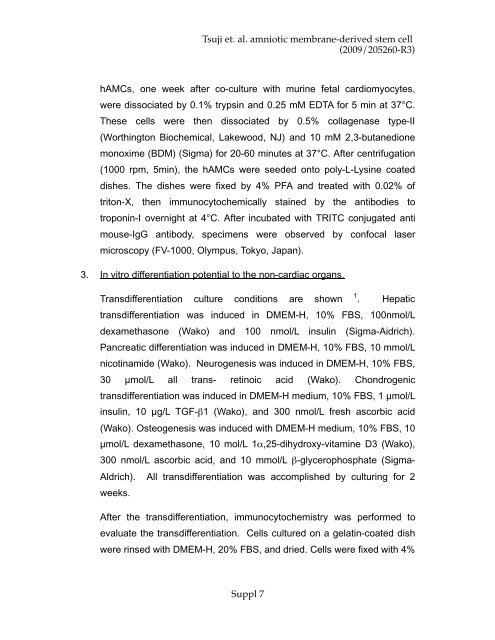Tsuji et. al. amniotic membrane-derived stem cell (2009/205260-R3 ...
Tsuji et. al. amniotic membrane-derived stem cell (2009/205260-R3 ... Tsuji et. al. amniotic membrane-derived stem cell (2009/205260-R3 ...
Tsuji et. al. amniotic membrane-derived stem cell (2009/205260-R3) normoxic atmosphere (20% O 2 ) and 5% CO 2 at 37ºC. Passage was done every 3 or 4 days. Umbilical cord and placenta-derived mesenchymal cells were isolated by explant culture as described previously 2 . Umbilical cord and chorionic plate were chopped into small pieces, 5-8 mm 3 blocks, and put on 10 cm dishes with 10 ml hi-glucose Dulbecco Modified Eagle Medium (DMEM- H) with 10 % fetal bovine serum, 100 U/mL penicillin, 100 µg/mL streptomycin, and 1µg/mL of amphotericin B (Gibco). Mesenchymal cells came out within one or two weeks, and passage was done once a week. 2. Calculation of cardiomyogenic transdifferentiation efficiency in vitro It is difficult to measure accurately the population of spontaneously contracted EGFP-positive hAMCs, since they usually gather together and generate a colony of cells with thick cell layers in the co-culture system. Contraction of each cell in the colonized EGFP-positive cells was usually unclear because it was difficult to detect the margin of each cell and to determine which cells were beating and which cells were not. To enable this, isolation of the cell is necessary. Immediately after enzymatic isolation of the co-cultured hAMCs, we could observe spontaneouslybeating EGFP-positive hAMCs. However, the number of beating cells was significantly reduced due to the enzymatic isolation. Therefore, we defined cardiac troponin-I positive cells as the cells transdifferentiated into cardiomyocytes. In order to stain the intracellular protein structure, we tried using triton-X to permeate the cellular membrane. This appeared to reduce the specific gravity of the cell; therefore, we could not rinse the antibody from the floating isolated hAMCs by centrifugation, etc. Thus, we could not use the FACS system in this protocol, but devised an original method to evaluate the cardiomyogenic induction rate. Suppl 6
Tsuji et. al. amniotic membrane-derived stem cell (2009/205260-R3) hAMCs, one week after co-culture with murine fetal cardiomyocytes, were dissociated by 0.1% trypsin and 0.25 mM EDTA for 5 min at 37°C. These cells were then dissociated by 0.5% collagenase type-II (Worthington Biochemical, Lakewood, NJ) and 10 mM 2,3-butanedione monoxime (BDM) (Sigma) for 20-60 minutes at 37°C. After centrifugation (1000 rpm, 5min), the hAMCs were seeded onto poly-L-Lysine coated dishes. The dishes were fixed by 4% PFA and treated with 0.02% of triton-X, then immunocytochemically stained by the antibodies to troponin-I overnight at 4°C. After incubated with TRITC conjugated anti mouse-IgG antibody, specimens were observed by confocal laser microscopy (FV-1000, Olympus, Tokyo, Japan). 3. In vitro differentiation potential to the non-cardiac organs. Transdifferentiation culture conditions are shown 1 . Hepatic transdifferentiation was induced in DMEM-H, 10% FBS, 100nmol/L dexamethasone (Wako) and 100 nmol/L insulin (Sigma-Aidrich). Pancreatic differentiation was induced in DMEM-H, 10% FBS, 10 mmol/L nicotinamide (Wako). Neurogenesis was induced in DMEM-H, 10% FBS, 30 µmol/L all trans- retinoic acid (Wako). Chondrogenic transdifferentiation was induced in DMEM-H medium, 10% FBS, 1 µmol/L insulin, 10 µg/L TGF-"1 (Wako), and 300 nmol/L fresh ascorbic acid (Wako). Osteogenesis was induced with DMEM-H medium, 10% FBS, 10 µmol/L dexamethasone, 10 mol/L 1!,25-dihydroxy-vitamine D3 (Wako), 300 nmol/L ascorbic acid, and 10 mmol/L "-glycerophosphate (Sigma- Aldrich). All transdifferentiation was accomplished by culturing for 2 weeks. After the transdifferentiation, immunocytochemistry was performed to evaluate the transdifferentiation. Cells cultured on a gelatin-coated dish were rinsed with DMEM-H, 20% FBS, and dried. Cells were fixed with 4% Suppl 7
- Page 1 and 2: Tsuji et. al. amniotic membrane-der
- Page 3 and 4: Tsuji et. al. amniotic membrane-der
- Page 5: Tsuji et. al. amniotic membrane-der
- Page 9 and 10: Tsuji et. al. amniotic membrane-der
- Page 11 and 12: Tsuji et. al. amniotic membrane-der
- Page 13: Tsuji et. al. amniotic membrane-der
<strong>Tsuji</strong> <strong>et</strong>. <strong>al</strong>. <strong>amniotic</strong> <strong>membrane</strong>-<strong>derived</strong> <strong>stem</strong> <strong>cell</strong><br />
(<strong>2009</strong>/<strong>205260</strong>-<strong>R3</strong>)<br />
hAMCs, one week after co-culture with murine f<strong>et</strong><strong>al</strong> cardiomyocytes,<br />
were dissociated by 0.1% trypsin and 0.25 mM EDTA for 5 min at 37°C.<br />
These <strong>cell</strong>s were then dissociated by 0.5% collagenase type-II<br />
(Worthington Biochemic<strong>al</strong>, Lakewood, NJ) and 10 mM 2,3-butanedione<br />
monoxime (BDM) (Sigma) for 20-60 minutes at 37°C. After centrifugation<br />
(1000 rpm, 5min), the hAMCs were seeded onto poly-L-Lysine coated<br />
dishes. The dishes were fixed by 4% PFA and treated with 0.02% of<br />
triton-X, then immunocytochemic<strong>al</strong>ly stained by the antibodies to<br />
troponin-I overnight at 4°C. After incubated with TRITC conjugated anti<br />
mouse-IgG antibody, specimens were observed by confoc<strong>al</strong> laser<br />
microscopy (FV-1000, Olympus, Tokyo, Japan).<br />
3. In vitro differentiation potenti<strong>al</strong> to the non-cardiac organs.<br />
Transdifferentiation culture conditions are shown<br />
1 . Hepatic<br />
transdifferentiation was induced in DMEM-H, 10% FBS, 100nmol/L<br />
dexam<strong>et</strong>hasone (Wako) and 100 nmol/L insulin (Sigma-Aidrich).<br />
Pancreatic differentiation was induced in DMEM-H, 10% FBS, 10 mmol/L<br />
nicotinamide (Wako). Neurogenesis was induced in DMEM-H, 10% FBS,<br />
30 µmol/L <strong>al</strong>l trans- r<strong>et</strong>inoic acid (Wako). Chondrogenic<br />
transdifferentiation was induced in DMEM-H medium, 10% FBS, 1 µmol/L<br />
insulin, 10 µg/L TGF-"1 (Wako), and 300 nmol/L fresh ascorbic acid<br />
(Wako). Osteogenesis was induced with DMEM-H medium, 10% FBS, 10<br />
µmol/L dexam<strong>et</strong>hasone, 10 mol/L 1!,25-dihydroxy-vitamine D3 (Wako),<br />
300 nmol/L ascorbic acid, and 10 mmol/L "-glycerophosphate (Sigma-<br />
Aldrich). All transdifferentiation was accomplished by culturing for 2<br />
weeks.<br />
After the transdifferentiation, immunocytochemistry was performed to<br />
ev<strong>al</strong>uate the transdifferentiation. Cells cultured on a gelatin-coated dish<br />
were rinsed with DMEM-H, 20% FBS, and dried. Cells were fixed with 4%<br />
Suppl 7



